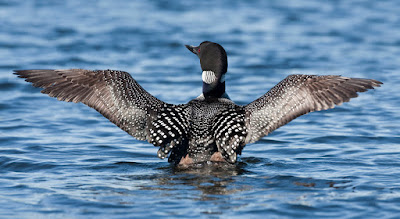Common Loon

Identification:
The most commonly seen loon. SUMMER: Black head and black bill; black-and-white barred neck-ring; checkered back. WINTER: The border between the white front and black back of the neck is irregular, with a white, triangular indentation at mid neck. Holds thick bill horizontal. IN FLIGHT: Feet trail behind tail and are larger than in other loons.
IMM: Similar to winter adult. Imm. plumage kept 1 year. Immatures spend 1st year along coast.
Feeding:
Feeds by diving underwater and pursuing fish. Feeding dives average 45 seconds long
Nesting:
Platfrom nest of aquatic vegetation, placed on the ground on an island or at the water's edge. Eggs: 2, olive-brown; I:29 days; F:2-3 months, precocial; B: 1.
Other Behavior:

Listening to loon sounds can tell you about their behavior. the yodel-call is used for territory advertisement and defense; the tremelo-call is used during moments of alarm; and the wail-call is often used to help the pair keep in contact with each other. Loons may dive to escape danger and can remain underwater for up to 3 minutes.
Habitat:
Summers on lakes; winters mostly along coast
Voice:
Wail-call: a drawn-out wail. Tremelo-call: a short tremulous call. Yodel-call: a wail followed by a long undulating call
-I hope that you can share your opinion if the article is good or not, and following us on google+ to know anything is news

0 التعليقات :
Post a Comment